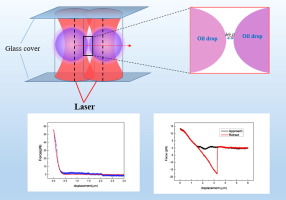当前位置:
X-MOL 学术
›
Chem. Eng. Sci.
›
论文详情
Our official English website, www.x-mol.net, welcomes your
feedback! (Note: you will need to create a separate account there.)
Determination of the Interaction Mechanism of 10 µm Oil-in-Water Emulsion droplets Using Optical Tweezers
Chemical Engineering Science ( IF 4.1 ) Pub Date : 2018-05-01 , DOI: 10.1016/j.ces.2018.03.012 An Chen , Yu Jing , Fu-Ning Sang , Shao-Wei Li , Jian-Hong Xu
Chemical Engineering Science ( IF 4.1 ) Pub Date : 2018-05-01 , DOI: 10.1016/j.ces.2018.03.012 An Chen , Yu Jing , Fu-Ning Sang , Shao-Wei Li , Jian-Hong Xu

|
Abstract A comprehensive understanding of the stability of an emulsion relies on a quantitative understanding of the dynamic interaction forces between the dispersed emulsion droplets. Microscale droplets have been widely used in various applications, for e.g., in food, cosmetics, controlled drug release, and biology. The dynamic interaction forces between two deformable emulsion droplets in the size range of 20–200 µm have been well-analysed using bubble/drop probe atomic force microscopy, whereas those of the emulsion droplets below 10 µm are rarely studied. In this work, we quantify the interaction forces between a pair of 1,6-hexanediol diacrylate (HDDA) droplets with a 10 µm diameter in an aqueous phase using optical tweezers (NanoTracker™ 2). By capturing two oil droplets in two separate optical traps and bringing them into close proximity, their interaction forces can be measured as a function of the separation distance. The force profiles are analysed using a theoretical model based on the augmented Young–Laplace equation that includes the effects of disjoining pressure. The interaction forces between two 10 µm HDDA oil droplets with SDS molecules adsorbed at their interfaces could be well-described using the classical Derjaguin–Landau−Verwey–Overbeek theory. This work demonstrates a useful methodology to quantify the interaction forces between microscale emulsion droplets with pN force precision, providing a deeper understanding of the stabilization mechanism of O/W emulsions and can be extended to many other emulsion systems. This work has been selected by the Editors as a Featured Cover Article for this issue.
中文翻译:

使用光镊测定 10 µm 水包油乳液液滴的相互作用机制
摘要 对乳液稳定性的全面理解依赖于对分散乳液液滴之间动态相互作用力的定量理解。微尺度液滴已广泛用于各种应用,例如食品、化妆品、药物控制释放和生物学。使用气泡/液滴探针原子力显微镜已经很好地分析了尺寸范围为 20-200 µm 的两个可变形乳液液滴之间的动态相互作用力,而很少研究小于 10 µm 的乳液液滴的动态相互作用力。在这项工作中,我们使用光镊 (NanoTracker™ 2) 量化了水相中直径为 10 µm 的一对 1,6-己二醇二丙烯酸酯 (HDDA) 液滴之间的相互作用力。通过在两个独立的光阱中捕获两个油滴并将它们拉近,它们的相互作用力可以作为分离距离的函数来测量。使用基于增强杨拉普拉斯方程的理论模型分析力分布,该方程包括分离压力的影响。两个 10 µm HDDA 油滴与吸附在其界面上的 SDS 分子之间的相互作用力可以使用经典的 Derjaguin-Landau-Verwey-Overbeek 理论很好地描述。这项工作展示了一种有用的方法来量化具有 pN 力精度的微尺度乳液液滴之间的相互作用力,提供对 O/W 乳液稳定机制的更深入理解,并可扩展到许多其他乳液系统。这项工作已被编辑选为本期的特色封面文章。
更新日期:2018-05-01
中文翻译:

使用光镊测定 10 µm 水包油乳液液滴的相互作用机制
摘要 对乳液稳定性的全面理解依赖于对分散乳液液滴之间动态相互作用力的定量理解。微尺度液滴已广泛用于各种应用,例如食品、化妆品、药物控制释放和生物学。使用气泡/液滴探针原子力显微镜已经很好地分析了尺寸范围为 20-200 µm 的两个可变形乳液液滴之间的动态相互作用力,而很少研究小于 10 µm 的乳液液滴的动态相互作用力。在这项工作中,我们使用光镊 (NanoTracker™ 2) 量化了水相中直径为 10 µm 的一对 1,6-己二醇二丙烯酸酯 (HDDA) 液滴之间的相互作用力。通过在两个独立的光阱中捕获两个油滴并将它们拉近,它们的相互作用力可以作为分离距离的函数来测量。使用基于增强杨拉普拉斯方程的理论模型分析力分布,该方程包括分离压力的影响。两个 10 µm HDDA 油滴与吸附在其界面上的 SDS 分子之间的相互作用力可以使用经典的 Derjaguin-Landau-Verwey-Overbeek 理论很好地描述。这项工作展示了一种有用的方法来量化具有 pN 力精度的微尺度乳液液滴之间的相互作用力,提供对 O/W 乳液稳定机制的更深入理解,并可扩展到许多其他乳液系统。这项工作已被编辑选为本期的特色封面文章。











































 京公网安备 11010802027423号
京公网安备 11010802027423号